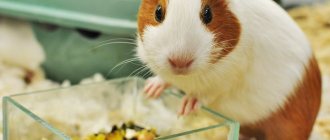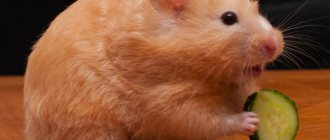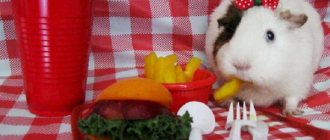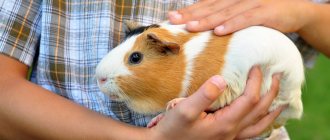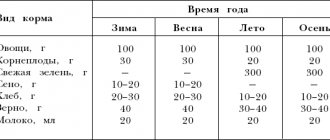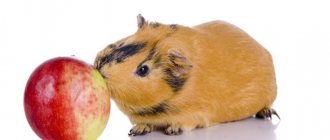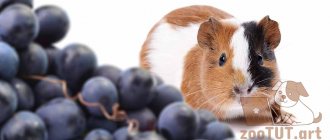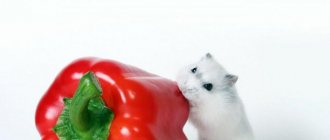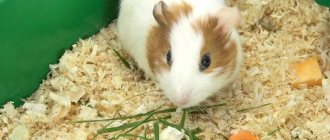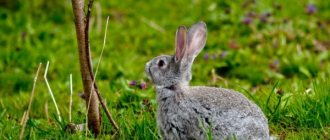- home
- Guinea pig
- Guinea pig nutrition
03/11/2019 Food of plant origin is ideal for feeding rodents, guinea pigs are no exception. However, even the healthiest foods, if not fed properly, can cause harm to your pet’s body. Cucumbers and tomatoes are the most popular vegetables, especially in the summer season, and many owners wonder whether they can be given to their pet? Obviously, they can bring a lot of benefits to the guinea pig's body, but you should follow the precautions when feeding.
How to feed vegetables
To provide your pet with all the necessary vitamins and microelements, you need to include fresh vegetables and fruits in its diet. They should be given in small quantities, about 80-120 grams per day, washed thoroughly before feeding and cut into pieces, but not grated. The pieces should be small so that the pig can eat them completely. Uneaten pieces must be immediately removed from the cage and thrown away, preventing them from rotting. Spoiled and rotten food should not be fed to guinea pigs.
It is best to use products grown in your own garden or garden. But if you don’t have your own plot of land or cottage, then it is advisable to buy vegetables, herbs and fruits in season, avoiding products grown with the use of pesticides and treated with various drugs.
Let's figure out what vegetables guinea pigs can eat and how they are good for your pets.
Fruits and berries
Can guinea pigs have bananas? A banana rich in potassium will benefit your guinea pig, but you should not give more than 1 piece per day.
The peel of the vegetable must be removed, as it is treated with substances hazardous to health (wax, chemicals, ethylene and pesticides). For safety, it is better to remove soft fibers from the fruit.
Can guinea pigs eat a pear?
Pears can be given with the peel, but without the seeds. The fruit is washed well and cut into pieces; the pig should be offered water along with it. Excessive consumption of pears due to their high sugar content can cause diarrhea.
Can guinea pigs eat kiwi?
Kiwi is a very healthy fruit for animals. It contains a large amount of ascorbic and folic acids. It is also rich in vitamins E, iron, calcium, magnesium and phosphorus.
Kiwi is given without skin in the form of small pieces. For your pet, you need to choose harder fruits. It is better to control the amount you eat. An increase in the dose of kiwi is permissible in autumn and winter, as well as when feeding females during pregnancy and lactation.
Can guinea pigs have oranges and other citrus fruits?
Can be used occasionally. But it is better for guinea pigs to get vitamin C from other foods, avoiding citrus fruits. Possible complications:
- oversaturation with vitamins;
- skin irritation;
- oxidation of urine.
Can guinea pigs eat apples?
Apples can be raw or dried. They have a balanced ratio of sugar and fructose (18:80%). It allows the pig to be active.
The fruit must be peeled and cut into slices. It is better not to give more than 3 pieces at a time.
Can guinea pigs eat strawberries, grapes and other berries?
Strawberries contain a sufficient amount of vitamin C to pay attention to the berry when choosing a treat for a rodent. You can also give strawberry leaves to animals.
- The pig might like grapes. You can offer the animal seedless grapes.
- Eating currants once a week will also not harm your pet.
- If you do not abuse it, you can offer the pig berries and raspberry leaves, berries, leaves and branches of blueberries, blackberries and sea buckthorn, and rose hips without seeds.
- Cranberries are given for medicinal purposes. It has an anti-inflammatory effect on the mucous membranes of the mouth, stomach, and bladder.
cucumbers
Most often, owners are interested in whether guinea pigs can eat cucumbers. These vegetables contain 2-6% dry matter - sugars, fiber, protein, some vitamins and microelements. 94-98% of the total mass of a cucumber is water, so this vegetable has little nutritional value. But, despite this, cucumber helps the rodent’s body digest other foods and absorb fats. You can give cucumbers to guinea pigs in small quantities and, preferably, your own, since poisoning often occurs due to the nitrates contained in purchased cucumbers. Overfeeding cucumbers can lead to digestive problems.
About the benefits of succulent feed
Nettle
Common stinging nettle has a number of beneficial properties and vitamins. It contains a lot of vitamin C, carotene, B vitamins and carotene. Fresh or dried nettle is a good natural vitamin concentrate. Young nettle leaves are also rich in protein, starch, chlorophyll, carbohydrates and iron salts, potassium and copper, manganese and titanium, nickel, many types of tannins and organic acids. Another advantage of nettle is that it is nutritious. Nettle leaves and shoots contain a large amount of proteins, fiber, and fats.
The leaves can be fed whole, or they can be made into powder and added to the main grain or concentrated feed. It is best to harvest nettles before flowering begins. Young shoots are mowed or only leaves are collected. Dry without pre-washing in a well-ventilated area, but out of direct sunlight.
Dandelion
This common and familiar plant is very useful for guinea pigs and in the summer it must be included in the animal’s diet. The leaves and roots of the plant are fed. Dandelion leaves are very rich in carotenoids, vitamin C, vitamins B and P. Dandelion leaves are good to use to improve digestion in animals, as well as to increase appetite. Dandelion roots are rich in sugar, inulin, and malic acid.
Spinach
Young spinach leaves are suitable for feeding. Spinach is also a source of large amounts of vitamins and proteins, iron salts, calcium and phosphorus. Just one hundred grams of spinach contains more than 700 mg of potassium.
Spinach can be fed not only fresh, but also dried and even frozen.
Cabbage
Headed cabbage is suitable for feeding fresh. Red cabbage is considered more nutritious and rich in vitamins. White and red cabbage is rich in vitamins C, carotene, B vitamins and iodine, pantothenic acid and many salts important for animal health. However, do not forget that cabbage leaves cause fermentation and gas formation in the intestines, so it is not recommended to feed a lot of cabbage leaves per day. Brussels sprouts can also be used to feed guinea pigs. It is rich in ascorbic acid, proteins, carotene, vitamins and salts of sodium, phosphorus and iron, as well as iodine and potassium.
Broccoli is also suitable for feeding. This type of cabbage is nutritious and high in sugar, carotenes, choline, and methionine. Broccoli is very rich in calcium. A big plus of broccoli is that it can be frozen and fed even in winter.
Lettuce leaves
Lettuce is a favorite food of guinea pigs. Regular leaf lettuce sprouts quite quickly and forms rosettes, so many breeders even grow it in pots at home. Lettuce leaves are rich in sugar and metals important for the guinea pig’s body:
Lettuce leaves contain almost all known vitamins and folic acid. Regular feeding of lettuce helps improve digestion and has a good effect on the pig's metabolism and appearance.
Parsley and dill
Our usual parsley and dill are high in vitamin C and carotene. Dill is especially recommended for guinea pigs during pregnancy and nursing. Dill not only increases milk production, but also improves the nutritional quality of milk. It is recommended to feed parsley to young animals and guinea pigs during the molting period, as well as after illness.
Tomatoes
Can guinea pigs eat tomatoes? These vegetables contain vitamins A and C, macro- and microelements, pectins and organic acids. Pets can only eat ripe vegetables, since green ones contain solanine, a toxic substance that is destroyed when tomatoes ripen. Pigs should not have green parts of tomatoes - tops and leaves. Tomatoes should be fed in small quantities and only from your garden. Overfeeding tomatoes can cause diarrhea.
Fruits and berries
Can guinea pigs have bananas? A banana rich in potassium will benefit your guinea pig, but you should not give more than 1 piece per day.
The peel of the vegetable must be removed, as it is treated with substances hazardous to health (wax, chemicals, ethylene and pesticides). For safety, it is better to remove soft fibers from the fruit.
Can guinea pigs eat a pear?
Pears can be given with the peel, but without the seeds. The fruit is washed well and cut into pieces; the pig should be offered water along with it. Excessive consumption of pears due to their high sugar content can cause diarrhea.
Can guinea pigs eat kiwi?
Kiwi is a very healthy fruit for animals. It contains a large amount of ascorbic and folic acids. It is also rich in vitamins E, iron, calcium, magnesium and phosphorus.
Kiwi is given without skin in the form of small pieces. For your pet, you need to choose harder fruits. It is better to control the amount you eat. An increase in the dose of kiwi is permissible in autumn and winter, as well as when feeding females during pregnancy and lactation.
Can guinea pigs have oranges and other citrus fruits?
Can be used occasionally. But it is better for guinea pigs to get vitamin C from other foods, avoiding citrus fruits. Possible complications:
- oversaturation with vitamins; skin irritation; oxidation of urine.
Can guinea pigs eat apples?
Apples can be raw or dried. They have a balanced ratio of sugar and fructose (18:80%). It allows the pig to be active.
The fruit must be peeled and cut into slices. It is better not to give more than 3 pieces at a time.
Can guinea pigs eat strawberries, grapes and other berries?
Strawberries contain a sufficient amount of vitamin C to pay attention to the berry when choosing a treat for a rodent. You can also give strawberry leaves to animals.
- The pig might like grapes. You can offer the animal seedless grapes. Eating currants once a week will also not harm your pet. If you do not abuse it, you can offer the pig berries and raspberry leaves, berries, leaves and branches of blueberries, blackberries and sea buckthorn, and rose hips without seeds. Cranberries are given for medicinal purposes. It has an anti-inflammatory effect on the mucous membranes of the mouth, stomach, and bladder.
Carrot
Carrots are a very healthy vegetable containing pectin, carotene, vitamins C, E, K, group B, and microelements. The substances contained in carrots have a beneficial effect on metabolic processes in the pig’s body, thereby improving the pet’s vision, hearing, and condition of the skin and coat. You can also feed carrot tops, which are also useful. Eating this vegetable may cause your pet's urine to turn orange.
Potato
But whether guinea pigs can have potatoes is of interest to most guinea pig breeders. Potatoes contain a large amount of starch, proteins, and vitamins. It is not recommended to give potatoes to guinea pigs. Raw potatoes contain starch that is difficult to digest, so if you decide to give your pet potatoes, give them a very small amount. Green tubers, green sprouts and potato tops contain a lot of poisonous solanine. Therefore, tubers that have turned green and have been stored for a long time should not be fed.
Other products
Can guinea pigs eat bread? It's better not to give.
Fresh yeast bread takes a long time to digest and causes fermentation in the animal’s stomach. White bread causes bloating. Your pet can eat stale bread, but not often. Dried bread with seeds, sesame seeds and raisins can sometimes be offered to your pet as a treat.
Can guinea pigs eat nuts and seeds?
Nuts and seeds are among the allowed foods, but can cause obesity if their consumption is not limited. It is better to offer your pet almonds, walnuts or hazelnuts.
The seeds contain many components useful for the animal: fatty acids, calcium, sodium, phosphorus, proteins and vitamins. It is better to give peeled seeds and make sure that they are no more than 15% of the total feed.
Cabbage
Can guinea pigs eat cabbage? There is an opinion that cabbage is contraindicated for guinea pigs, that this vegetable causes problems with the digestive system. In fact, cabbage is a healthy vegetable containing a lot of protein, vitamins and microelements.
If you have a healthy pet, not prone to bloating, and you gradually and in small quantities introduce cabbage and other succulent foods into the diet, then your guinea pig will not have problems with digestion. And if you do not follow your pet’s diet and immediately introduce new foods without accustoming your pig to them, then problems with the intestines cannot be avoided. Small amounts of cabbage, cauliflower, Brussels sprouts, broccoli and kohlrabi can be fed infrequently. Do not feed early, greenhouse cabbage.
Guinea pig diet
These furry animals should not be fed only dry or exclusively wet food. The guinea pig menu must be balanced and evenly introduce foods of varying degrees of juiciness. It is very important to remember to have a varied diet. Guinea pigs are fed 3-4 times a day.
The animals' diet should include:
- Fresh greens. (15–20% of the daily amount of food) – dandelion leaves, green salads, and beet tops are extremely useful for rodents;
- Grain mixtures. (Approximately 30% of the average daily amount of products) - their main components are cereals, corn, oat grains, peas;
- Fruit and vegetable treats. (About 30% of the total food);
- Dry herbs. (5–10%) - they are bought at a pet store, collected in the meadow or taken from the garden.
Zoologists recommend regularly treating your furry pets with young twigs and leaves of fruit plants. From time to time, it is necessary to add a small proportion of fat-containing products (10–15%) to the animal’s menu.
The average daily intake of succulent food for a guinea pig is approximately 50–100 g. Domestic rodents have different weights, ages, and health conditions. Therefore, it is better to discuss the individual average daily nutritional intake with your veterinarian. The total amount of food for 1 animal per day should not exceed 450 g.
Jerusalem artichoke
The entire Jerusalem artichoke plant, leaves, flowers, roots, is edible for guinea pigs. Jerusalem artichoke contains a large amount of fiber and essential amino acids - lysine, leicine, arginine. Root vegetables contain inulin, a natural analogue of insulin, which is why Jerusalem artichoke is recommended for those prone to diabetes. But root vegetables should not be given to marine animals often, since they are considered concentrated feed, and young tubers contain poorly digestible starch, which can cause intestinal disorders.
Rough (solid) feed
Rough (solid) food is primarily hay, grain and special pellets (pelleted food, which is sold in pet stores).
You can easily do without the latter, but it is very convenient to use and helps out in many cases, especially in winter. Guinea pigs usually crunch with pleasure at such gourmet incas right there, like chickens in a backyard, they rush to the feeder, clinging to it from all sides until they find it and eat everything that they love most. Currently, ready-made, pre-mixed dry food granules have appeared on the market, specially prepared for guinea pigs, which contain added vitamin C. It must be taken into account that due to the addition of vitamin C, the food usually has a short shelf life, about 3 months. Such food must always be stored in a dry place and in tightly closed packaging, otherwise it will quickly become moldy and spoil. Good hay
is a so-called stimulant that prevents intestinal dysfunction in pigs. It should also be very fresh, not small or dusty and fresh-smelling. The hay should be without any coarse or large twigs, and for long-haired pigs, it is better to give the hay cut or rolled into a roll or tied. Otherwise, long hair gets tangled in the hay very easily.
Watermelon
Guinea pigs can be given a little watermelon during the summer season. Try to give ripe pulp, and it is advisable not to give the white part closer to the rind, since it is in this part that nitrates accumulate. For the same reason, pigs should not be given early vegetables. Watermelon is a diuretic, so indulge your pet with it infrequently.
In what form should it be offered?
All vegetables are offered to the animal only fresh. Salted, pickled, canned fruit is harmful food for your pet. Any pickles and preserves contain sugar, vinegar, spices and a large amount of salt. These spices are not allowed on the menu of a tiny animal.
A high-quality harvest from the garden will improve your pet’s diet, making it healthy and varied.
What else can you pamper your pet from your own garden? Read about this in the following articles: “Can a guinea pig eat peas and corn?” and “Can guinea pigs have apples and pears?”
Source
Melon
The same goes for melon. This vegetable is given from your own garden or purchased in season. It is also not recommended to give melon frequently; it is very sweet and can contribute to the development of diabetes.
We tried to consider in as much detail as possible and give answers to the question “What vegetables can guinea pigs eat?” As you can see, most vegetables are not only possible, but also should be given to guinea pigs. The most important thing is a properly formulated and balanced diet for your pet, including products grown without chemicals. To keep your guinea pig healthy and cheerful, stick to proper nutrition and your pet will thank you with its playful behavior and healthy appearance.
So, we have dealt with the question of what vegetables can guinea pigs eat, but we described in this article whether your pet can eat grass. You may be interested in this information.
Did you like the article? Share with friends: [supsystic-social-sharing id=”1"]
- Related Posts
- Lice eaters in guinea pigs
- How to determine the sex of a guinea pig
- Can guinea pigs have grass?
« Previous entry
Grain feed
A guinea pig needs to eat at least 20% grain per day. Grain food for rodents is sold in any pet store. The finished product usually includes:
- barley;
- oats;
- millet;
- sunflower seeds;
- corn grains.
In addition to grain, prepared feeds may include vegetable granules and vitamin supplements.
Dry pet food is easy to prepare yourself; you just need to buy different types of grains on the market and then mix them. But you need to take into account that the main ingredient is oats; guinea pigs eat it more readily than other grains. Solid grain food should always be present in the diet of rodents. Animals need it to grind down their continuously growing teeth. If a rodent eats only raw and soft food, then its incisors become unnaturally elongated and interfere with the ability to absorb food. As a result, the animal dies from starvation.
